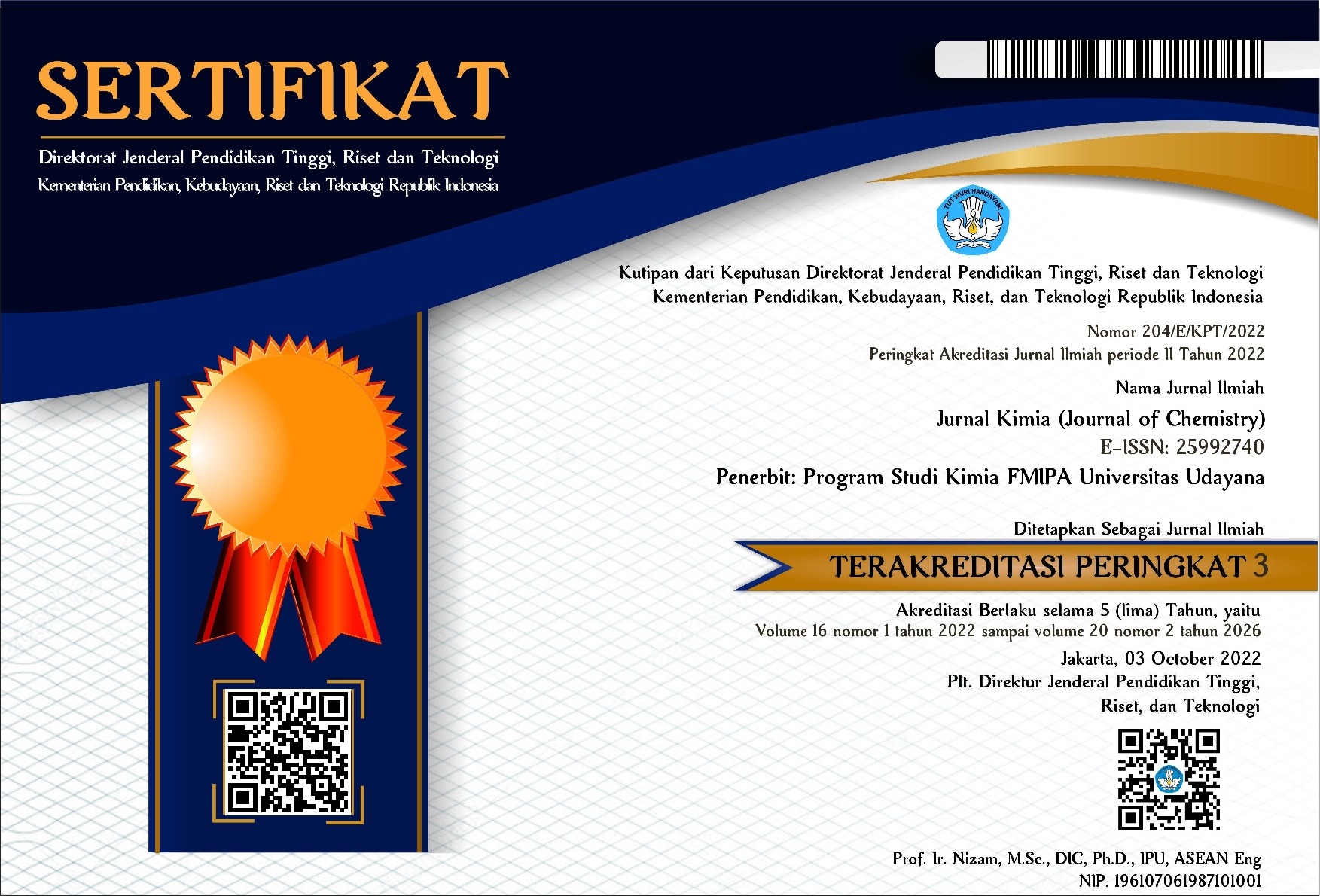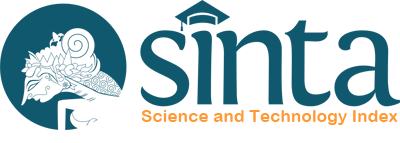AKTIVITAS ANTIBAKTERI DAN KANDUNGAN SENYAWA EKSTRAK n-HEKSANA KULIT PISANG PECAH SERIBU (Musa × paradisiaca L.)
-
Abstract
Kulit pisang pecah seribu (Musa x paradisiaca L.) merupakan sampah organik yang belum dikenal luas manfaatnya. Tujuan dari riset ini adalah untuk menetapkan konsentrasi hambat minimum (KHM) dan konsentrasi bunuh minimum (KBM) ekstrak n-heksana kulit pisang pecah seribu, dan mengetahui kandungan senyawa dalam ekstrak kasar n-heksana. Ekstraksi kulit pisang pecah seribu dibuat dengan cara maserasi dan partisi, uji aktivitas antibakteri dilaksanakan dengan metode sumur difusi agar, dan identifikasi senyawa aktif memakai Gas Chromatography–Mass Spectrometry (GC-MS). Maserasi 680 g serbuk kulit pisang pecah seribu dengan 7 L metanol menghasilkan 101,10 g ekstrak kental metanol. Partisi ekstrak kental metanol menghasilkan 15,55 g ekstrak kental n-heksana. Hasil uji aktivitas antibakteri menunjukkan nilai KHM dari ekstrak n-heksana kulit pisang pecah seribu sebesar 3,125% baik terhadap bakteri S. aureus maupun E. coli sedangkan KBM ekstrak kasar n-heksana pada 25% pada bakteri S. aureus dan E. coli. Senyawa antibakteri dalam ekstrak n-heksana diantaranya limonen, asam palmitat, dan timol.
Kata kunci: Antibakteri, Escherichia coli, GC-MS, Musa × paradisiaca L., dan Staphylococcus aureus.
ABSTRACT
Pecah seribu banana peels (Musa x paridisiaca L.) is an organic waste that can be used as traditional medicine. The study aimed to determine the Minimum Inhibitory Concentration (MIC) and Minimum Bactericidal Concentration (MBC) of n-hexane extract of pecah seribu banana peels, and to recognize the compounds contained in n-hexane crude extract of the pecah seribu banana peels. Extraction of the peels was carried out using maceration and partitioning methods and antibacterial activity test using agar diffusion well method, and the identification of active compounds using Gas Chromatography – Mass Spectrometry (GC-MS). Maceration of 680 grams of pecah seribu banana peels powder with 7 liters of methanol produced 101,10 grams of thick methanol extract. The partition of the methanol extract produced 15.55 grams of n-hexane thick extract. The results of the antibacterial activity test showed that the MIC of n-hexane crude extract was 3.125% against both Staphylococcus aureus and Escherichia coli bacteria. The MBC of n-hexane crude extract was 25% against S. aureus and E. coli bacteria. The antibacterial compounds in the n-hexane extract include limonene, palmitic acid, and thymol.
Keywords: Antibacterial, Escherichia coli, GC-MS, Musa x paridisiaca L., and Staphylococcus aureus.
Downloads
References
Asih, I.A.R.A., Rita, W.S., Ananta, I G.B.T., dan Wahyuni, N.K.D.M.S. 2018. Aktivitas Antibakteri Ekstrak Kulit Pisang (Musa sp.) terhadap Escherichia coli dan Staphylococcus aureus serta Identifikasi Golongan Senyawa Aktifnya. Indonesian E-Journal of Applied Chemistry. 6(1): 56-63.
Bota, W. 2015. Potensi Senyawa Minyak Sereh Wangi (Citronella oil) dari Tumbuhan Cymbopogon nardus sebagai Agen Antibakteri. Fakultas Teknik. Universitas Muhammadiyah. Jakarta.
Delima, A. A., Pratiwi U. M., Asriani, dan Sari I. 2019. Potensi Aktivitas Antimikroba Madu dan Habatussauda terhadap Bakteri Escherichia coli Secara In Vitro. Indonesian Journal of Clinical Nutrition Physician. 2(1): 11-19.
Ehiowemwenguan, G., Emoghene, A. O., and Inetianbor, J. E. 2014. Antibacterial and Phytochemical Analysis of Banana Fruit Peel. IQSR Journal of Pharmacy. 4(8): 18-25.
Gunawi, R. H., Kurniawan, D. W., dan Ratna, U. V. V. F. 2015. Peningkatan Laju Disolusi Tablet Piroksikam Menggunakan Polisorbat 80. Acta Pharmaciae Indonesia. 1(1): 8-15.
Hassan, S. W. M. 2016. Antibacterial, anticoagulant and anti-inflammatory activities of marine Bacillus cereu. Journal of Pure and Applied Microbiology. 10(2): 2593-2606.
Iskandar, D. 2020. Aplikasi Uji Skrining Fitokimia terhadap Daun Uncaria tomentosa Sebagai Bahan Utama Dalam Pembuatan Teh. Jurnal Teknologi Technoscientia. 12(2): 153-158.
Karunia, S. D., Supartono, dan Sumarni, W. 2017. Analisis Sifat Antibakteri Ekstrak Biji Srikaya (Annona squamosal L.) dengan Pelarut Organik. Indonesian Journal of Chemical Science. 6(1): 57-60.
Kawaroe, M., Tri, P., Ayi, R., dan Dahlia, Y. 2014. Laju Pertumbuhan Spesifik dan Kandungan Asam Lemak pada Mikroalga Spirulina platensis, Isochrysis sp. dan Porphyridium cruentum. Jurnal Ilmu Kelautan. 17(3): 125-131.
Nagle PS, Pawar YA, Sonawane AE, Nikum AP, Patil UD, More DH. 2013. Thymol: Synthesis, reactions & its spectrum of pharmacological and chemical applications. Indo American Journal of Pharm Research. 3: 7549-7561.
Ningsih, A. P., Nurmiati, dan Agustien, A. 2013. Uji Aktivitas Antibakteri Ekstrak Kental Tanaman Pisang Kepok Kuning (Musa paradisiaca Linn.) terhadap Staphylococcus aureus dan Eschericia coli, Jurnal Biologi. 2(3): 207-213.
Padmini, E.A., Valarmathi, A., and Rani, M.U. 2018. Comparative Analysis of Chemical Composition and Antibacterial Activities of spicata and Camellia sinennsis. Asian Journal Science. 1(2): 772-781.
Patricia, A. D., Jumaeri, dan Mahatmanti W. 2019. Uji Daya Antibakteri Gel Hand Sanitizer Minyak Atsiri Seledri (Apium graveolens). Indonesian Journal of Chemical Science. 8(1): 29-33.
Resaputra, I.H. 2020. Uji Aktivitas dan Identifikasi Senyawa Antibakteri Kulit Pisang Pecah Seribu (Musa x paradisiaca L.) terhadap Bakteri Staphylococcus aureus dan Escherichia coli. Skripsi. Universitas Udayana. Denpasar.
Retnowati, Y., N. Bialangi, dan N.W. Posangi. 2017. Pertumbuhan Bakteri Staphylococcus aureus pada Media yang Diekspos dengan Infus Daun Sambiloto (Andrographis paniculata). Jurnal Saintek. 6(2): 11-20.
Rita, W.S., Resaputra, I.H., dan Sukadana, I.M. 2020. Aktivitas Antibakteri Ekstrak Metanol Kulit Pisang Pecah Seribu (Musa x paradisiaca L.) Terhadap Bakteri Staphylococcus aureus dan Escherichia coli. Indonesian E-Journal of Applied Chemistry. 8(2): 82-91.
Rita, W.S., Asih, I.A.R.A., Swantara, I.M.D., and Damayanti, N.L.Y. 2021. Antibacterial Activity of Flavonoids from Ethyl Acetate Extract of Milk Banana Peel (Musa x paradisiaca L.). Journal of Bioscience. 28(3): 223-231.
Sinarsih, N. K., Rita, W. S., dan Puspawati, N. M. 2016. Uji Efektivitas Ekstrak Daun Trembesi (Samanea saman (jacq.) Merr) Sebagai Antibakteri Escherichia coli dan Staphylococcus aureus. Cakra Kimia. 4(2): 120-128.
Susanti, D. Y. 2018. Efek Suhu Pengeringan terhadap Kandungan Fenolik dan Kandungan Katekin Ekstrak Daun
Kering Gambir. Prosiding Seminar Nasional Teknik Pertanian. Yogyakarta.
Ventola CL. 2015. The antibiotic resistance crisis part 1: causes and threats. Journal Pharmacy and Therapeutics. 40(2): 277-283.
Wulansari, E. D., Lestari, D., dan Khoirunissa, M. A. 2020. Kandungan Terpenoid dalam Daun Ara (Ficus Carica L.) Sebagai Agen Antibakteri terhadap Bakteri Methicillin-Resistant Staphylococcus aureus. PHARMACON. 9(2): 219-225.
Yu, Z.J., Bernstein, E.R. 2013. On the decomposition mechanisms of new imidazole based energetic materials. J. Phys. Chem. 117: 1756–1764.

This work is licensed under a Creative Commons Attribution 4.0 International License





